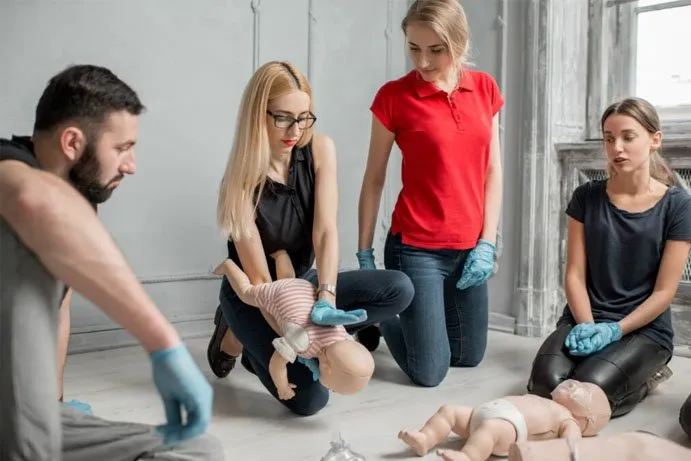Every second counts when a child’s health is at risk, and knowing how to respond confidently in an emergency can make all the difference. Paediatric first aid isn’t just about reacting swiftly; it’s about having the right knowledge and skills to act effectively when it matters most. Whether you’re a parent, teacher, or childcare professional, being prepared is a responsibility you can’t overlook.
But what exactly qualifies someone to handle these critical situations? Understanding the essential qualifications for paediatric first aid ensures you’re not only meeting legal requirements but also equipped with the expertise to provide the highest standard of care. From life-saving techniques to managing everyday injuries, the right training empowers you to protect the children in your care with confidence.
Importance Of Paediatric First Aid
Understanding paediatric first aid equips you with the tools needed to respond effectively during emergencies involving children. By knowing the correct procedures, you might prevent complications or even save a child’s life. Quick action often determines the outcome in scenarios like choking, burns, or head injuries. You carry a significant responsibility when caring for children, and every choice you make in critical moments can shape their recovery.
Children are naturally curious, which means accidents are more frequent than you might assume. Would you feel confident handling a child who’s swallowed a small object or showing signs of an allergic reaction? With proper paediatric first aid knowledge, you learn to identify symptoms early and address them while waiting for professional help. This isn’t just about treatment—it’s about recognising risks and acting decisively.
You should also consider that paediatric first aid training often extends to preventing harm. Does your environment pose risks you haven’t noticed? Your ability to assess the safety of spaces like playgrounds or nurseries may prevent injuries before they even occur. It empowers you to create safer conditions for children under your supervision.
When a child becomes ill or injured, their physical response may differ significantly from an adult’s. Children’s smaller, developing bodies mean injuries can escalate faster if mishandled. You must adapt your approach to their specific needs. For instance, treating a child during an asthma attack or a nosebleed requires different techniques than you’d apply to adults.
By obtaining this expertise, you demonstrate readiness that parents, schools, and childcare providers value highly. Can those who rely on you trust your ability to act during a crisis? They will, if you’ve invested in building these critical skills. Teaching children how to stay safe or involving them in age-appropriate safety practices might also form part of your broader role. Paediatric first aid lays the foundation for all of this, ensuring your actions consistently protect and enhance children’s wellbeing.
Key Skills To Acquire
CPR And Rescue Breathing
Effective CPR and rescue breathing form vital responses in paediatric first aid. You will learn how to assess unresponsiveness in children and infants quickly, ensuring oxygen circulation is restored until professional help arrives. Paediatric CPR differs from adult methods, so understanding techniques like compressions using two fingers for an infant or the heel of one hand for a child matters significantly. You might also encounter rescue breathing scenarios, where clearing airways and delivering gentle breaths tailored to a child’s capacity ensures proper care. Practice and precision become crucial when timing each action within set protocols.
Wound Care And Bandaging
Treating wounds requires more than simply cleaning and covering injuries. You will focus on recognising wound severity and applying sterile dressings to prevent infection. Children often sustain cuts or abrasions during play, making your competence in bandaging different body parts essential. Techniques like securing bandages without restricting circulation are standard, alongside handling situations involving embedded objects or severe bleeding. Knowing how to apply pressure effectively can also make a significant difference. These skills prepare you to manage injuries safely while reducing contamination risks.
Choking Management
Choking hazards are common among children due to small airways and shared curiosity. You learn to quickly identify partial or complete obstructions and respond through abdominal thrusts for older children or chest thrusts for infants. Recognising the urgency in silent choking episodes sharpens your observational skills. You might find that maintaining composure while delivering back blows ensures more efficient execution. Each step, from removing obstructions to monitoring recovery signs, builds your confidence in addressing this high-risk emergency.
Certifications And Training Programs
Understanding the value of proper certifications and high-quality training strengthens your ability to respond effectively in paediatric emergencies. These credentials help align your skills with industry standards, ensuring comprehensive care for children in critical moments.
Recognised Certification Bodies
You will find that certification from established organisations validates your expertise. The UK’s Resuscitation Council issues trusted accreditations focused on CPR and advanced life support. St John Ambulance and the British Red Cross are widely respected for their paediatric first aid courses. Additionally, ProTrainings delivers health-focused certifications that meet Ofsted-regulated childcare requirements. These bodies reflect credible, up to date training.
Online Vs. In-Person Training
Choosing between online or face-to-face training depends on your learning preferences and availability. Online options offer convenience and are particularly useful if you’re balancing work or family. Interactive video modules and timed assessments reinforce knowledge effectively. In-person courses, however, provide hands-on practice with immediate feedback from certified instructors. If you prefer gaining tactile experience, physical classroom settings might suit you better.
Legal And Ethical Responsibilities
Legal and ethical considerations form the foundation of paediatric first aid. You must adhere to these regulations to ensure your actions align with established protocols, safeguarding children and maintaining trust.
Understanding Consent
Gaining consent before administering aid is essential. You need to seek permission from the child’s parent or guardian if they’re present. In their absence, you act under implied consent, particularly when a child’s life is at risk. Older children capable of making decisions about their care should be asked directly. Consider carefully how you explain your intent, ensuring clarity and reassurance. If consent is refused, proceed only in critical emergencies where inaction might harm the child.
Confidentiality And Reporting Injuries
Respecting a child’s privacy involves safeguarding their personal and medical information. You should only share details with those directly involved in their care or when required by law. Accurate documentation of injuries, treatments, and relevant circumstances is necessary. This reporting is helpful for medical personnel and for fulfilling legal obligations, particularly in regulated environments like schools or nurseries. If signs of abuse or neglect arise, reporting to the appropriate authority becomes a mandatory step guided by legal frameworks.
Role Of Continued Education
Keeping your paediatric first aid knowledge fresh enhances your ability to respond effectively. Guidelines evolve, techniques improve, and new scenarios emerge, so staying updated is critical. You might think completing initial training is enough, but without ongoing education, key skills can fade—or worse, become outdated. Your confidence in emergency responses depends on consistent practice and exposure to updated protocols.
Continuing education introduces refinements in techniques, like adjustments to CPR practices or the latest choking management methods. You will find that training providers regularly update course materials, reflecting current research and best practices. In paediatric cases, changes often focus on improving outcomes in critical seconds—emphasising precision and speed.
A focus on continued education also helps reinforce skills you might rarely use, ensuring they’re accessible when needed most. Specific situations like handling anaphylaxis or knowing what to do for shock require confidence that only practice builds. You’ll see the value of refreshing these techniques during routine training, especially given the unique physiological responses of children.
Some courses incorporate advanced topics, appealing to experienced caregivers. These might include recognising chronic conditions that complicate emergencies or providing psychological first aid to traumatised children. Broader knowledge increases your preparedness for complex cases, allowing you to provide pre-professional care while awaiting medical support.
Mandatory re-certification often aligns with legal requirements. For example, certifications through the Resuscitation Council or St John Ambulance typically need renewal every three years. Re-certification is less about bureaucracy than sharpening your preparedness and ensuring your legal compliance when working with children.
Formal training aside, you can take informal steps to reinforce your competence. Peer discussions, observing health professionals, and self-assessing your readiness for specific emergencies all shape your expertise. Maintaining accuracy under pressure stems from good habits, which are easier to develop with ongoing study.
In the case that you pause between structured training, be proactive. Regularly reviewing key first aid principles ensures your capability doesn’t stall. Would you confidently act during a seizure, or deliver CPR for a child the right size? Continued education provides those answers.
Last Thoughts
Paediatric first aid is more than a skill; it’s a commitment to safeguarding children’s lives and wellbeing. By equipping yourself with the right qualifications and staying informed through continuous learning, you strengthen your ability to act decisively in emergencies.
Whether you’re a parent, teacher, or childcare professional, your preparedness reflects a dedication to creating safer environments for children. With proper training and awareness, you can handle critical situations confidently and responsibly, ensuring the best outcomes for those in your care.















